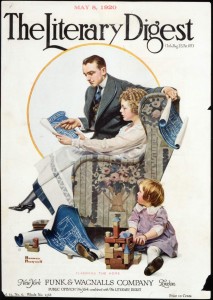
Norman Rockwell (1894-1978)|Planning the Home, 1920 (also known as, Family Reading Blueprints)|Illustration for the cover of The Literary Digest v. 65, no. 6 (May 8, 1920)|Oil on canvas|Private Collection
The Literary Digest was a popular general interest weekly magazine that began in 1890. In 1917, Norman Rockwell’s illustrations were being used by advertisers in the pages of The Literary Digest and the following year its’ publisher, Funk & Wagnalls, commissioned Rockwell to create his first cover for them.
The Literary Digest covers were made during the early years of Rockwell’s Saturday Evening Post covers. The circle surrounding the upper portion of this image makes me wonder if this cover might have been created first as a possible Saturday Evening Post cover.*The wife/home-maker in this illustration wears a pristine white bib-apron over her plaid skirt and sheer cotton blouse. Her black silk-stocking ankle is revealed below the skirt’s hem and she wears a shapely, fashionable, black patent-leather shoe which was very popular during this era. That the man and woman are married is indicated by the plain gold rings they wear on their left hands.
The husband’s clothing is more formal than his wife’s, probably because he has just come home from work. His suit coat is made from a heavier material, probably wool flannel which was common and popular at this time. The rolled collar lapel is not notched, but runs smoothly from the single waist level button up around the neck. The edges of the coat and cuffs have a sewn-in border of a contrasting material piping framing the jacket. A distinctive aspect of this business suit is that the vest is made of a different material. Until 1920 men’s suits came with a matching vest. In 1920, fashion dictated that the vest should be different. A fob and a bit of chain of his pocket watch are tucked through the top button of his vest. His neck tie is slipped neatly under a starched Florence-style collar of his white shirt. His shirt cuffs are closed with gold cuff links. The family’s stylish upscale fashions clearly marks them as members of the American upper middle class.
While the pretty little wife peruses the plans her handsome husband has brought home for her approval, she sits in a traditional wing-style chair. This type of chair was popular in American homes from the 18th century. Meant for a space without central heating, this chair would have been placed facing the fireplace so that the padded wings and tall back helped to hold the heat emanating from the fire and to limit drafts for those seated within its protection. This housewife has covered her old-fashioned wing chair with a very modern deco floral pattern. The foot stool, seen below her foot, is covered with the same material.
In the foreground of this illustration, the couple’s young child pauses and looks back at her parents as she constructs a building with blocks. In the post World War I period, Americans experienced both an economic boom and an explosion in the creation of residential neighborhoods within the cities and their bedroom suburbs. The blue-print of the house’s façade held in wife’s hands locates the lot where the house will go as “ORT ON-Ebb-NY,” indicating the couple plan to build their home in a community outside of New York City. A variety of similar Hart Schaffner & Marx men’s clothing ads from 1920 through 1922 show various groups of men looking over blue-print building plans, reinforcing the commonplace nature of this illustration’s focus and the building boom they illustrate. The couple’s plans show the proposed residence’s façade and floor plans for a two-story house. By the 1960s the blue-print process, printing white lines on a blue background, had mostly been replaced by architectural drawings that copy blue lines on a white background, but they are still called blue-prints.
* Unfortunately early records of Rockwell’s commissions were lost in a studio fire.
October 15, 2009
By Joyce K. Schiller, Curator, Rockwell Center for American Visual Studies
Norman Rockwell Museum






